Table of Contents
Discover Beautiful Belize in Under 5-Minutes
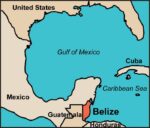
LOCATION
Belize, previously British Honduras, lies on the East coast of Central America and in the heart of the Caribbean Basin. It is bordered by Mexico to the North, Guatemala to the West and South, and the Caribbean Sea to the East. Geographically it is located between 15° 52′ 9″ and 18° 29′ 55″ North Latitude, and 87° 28″ and 89° 13′ 67″ West Longitude with an area of 8,866 sq. miles including 266 sq. miles of islands.
The cayes or islands, the offshore atolls, and the barrier reef are the main attractions to Belize. The barrier reef, which is the longest barrier reef in the Western Hemisphere, is 185 miles long. The cayes and atolls provide a great opportunity for SCUBA diving, snorkeling, fishing, boating, sailing, and kayaking, and also serve as a habitat for both nesting birds and turtles. In the central part of Belize, the land is higher. It is between 1,500 and 3,680 feet above sea level in the Mountain Pine Ridge Area and the Maya Mountains. Breathtaking waterfalls, historic Mayan cities, and majestic mountains are but a few of the attractions that can be enjoyed in this area.
CLIMATE
 The climate is subtropical, with a brisk prevailing wind from the Caribbean Sea. The country has an annual mean temperature of 79 degrees Fahrenheit, and the humidity is nicely tempered by the Sea breezes. The variation in weather further emphasizes the interesting difference in elevation, geology, plant and animal life. Summer high temperatures are normally around 98 degrees Fahrenheit, and winter lows have rarely gone below 60 degrees Fahrenheit, even at night.
The climate is subtropical, with a brisk prevailing wind from the Caribbean Sea. The country has an annual mean temperature of 79 degrees Fahrenheit, and the humidity is nicely tempered by the Sea breezes. The variation in weather further emphasizes the interesting difference in elevation, geology, plant and animal life. Summer high temperatures are normally around 98 degrees Fahrenheit, and winter lows have rarely gone below 60 degrees Fahrenheit, even at night.
RAINFALL
Normally, the rainy season is usually between June and November and the dry season is between February and May. Usually, the weather becomes cooler at the end of October and this lasts up until February. The average humidity is 85 percent. Annual rainfall ranges from 50 inches in the North to 170 inches in the South.
PEOPLE
The population of approximately 400,000 people consists of a mixture of Creoles, Garifunas, Mestizos, Mayas, Caucasians, Mennonites, Lebanese, Chinese, and East Indians. Belize has gained a widespread reputation for its friendly people.
LANGUAGE
English is the official language of Belize, Spanish is the second language and Creole is the commonly used dialect you will hear spoken throughout the country.
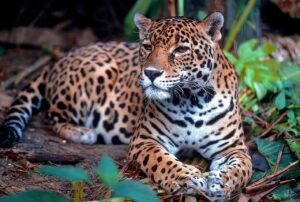 CURRENCY
CURRENCY
The Belize Dollar (BZ$) has a fixed rate of exchange of BZ$2 to US$1. Most hotels, resorts, restaurants, and tour operators will accept U.S. currency, traveler’s checks, or credit cards.
TIME
The time observed year-round is GMT-6, which is the same as United States Central Standard Time. Daylight Savings Time is not observed in Belize.
The Name Belize:
The origin of the name Belize is a little muddy, kind of like the Belize River after a rainstorm! The Mayan word for “muddy water” is belix so Belize may have been derived from it. Or, perhaps a swashbuckling buccaneer, named Peter Wallace, deserves credit for Belize’s name. Legend has it that Wallace, who settled in Belize in 1638, was initially pronounced as “Vallis” (as there is no “W” in Spanish) which became further corrupted into Balis or Belize. Our favorite theory combines the Spanish words Bella Isla (Beautiful Island) into the name Belize.
National Flag:
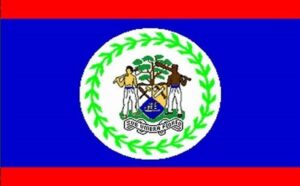 The shield of the Coat of Arms is divided into three sections by a vertical line and an inverted V. The base section represents a ship in full sail on waves of the sea. The two upper sections show tools of the timber industry in Belize: a paddle and a squaring axe in the right section and a saw
The shield of the Coat of Arms is divided into three sections by a vertical line and an inverted V. The base section represents a ship in full sail on waves of the sea. The two upper sections show tools of the timber industry in Belize: a paddle and a squaring axe in the right section and a saw
Supporting the shield are two woodcutters, the one on the right holding a beating axe over his shoulder in his right hand, and the one on the left holding a paddle over his shoulder in his left hand.
Above the shield rises a mahogany tree. Below the shield is the motto scroll. A wreath of leaves encircles the Coat of Arms. The Coat of Arms embodies an important aspect of the history of Belize, as the mahogany industry formed the basis of our economy in the 18th and 19th centuries. NATIONAL MOTTO: “Sub Umbra Florero” – These Latin words mean, “Under the shade, I flourish.”
National Flower:
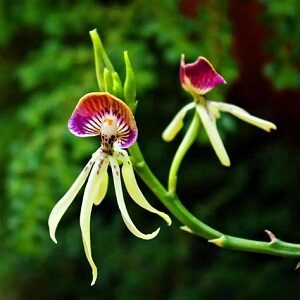 Encyclia Cochleatum is the National Flower of Belize. This orchid grows on trees in damp areas, and flowers nearly all year round. Its clustered bulblike stems vary in size up to six inches long and carry two or three leaves.
Encyclia Cochleatum is the National Flower of Belize. This orchid grows on trees in damp areas, and flowers nearly all year round. Its clustered bulblike stems vary in size up to six inches long and carry two or three leaves.
The black orchid flower has greenish-yellow petals and sepals with purple blotches near the base. The “lip” (one petal of special construction, which is the flower’s showiest) is shaped like a valve of a clam shell (hence the name Encyclia Cochleatum) and is deep purple-brown, almost black, with conspicuous radiating purple veins.
National Tree:
 The Mahogany Tree is truly the monarch of Belize’s forests. Towering above the canopy of the forest, Belize’s 100-foot Mahogany Trees reign supreme with their crown of shining, green leaves.
The Mahogany Tree is truly the monarch of Belize’s forests. Towering above the canopy of the forest, Belize’s 100-foot Mahogany Trees reign supreme with their crown of shining, green leaves.
Only through exposure to sunlight does the wood darken to a deep mahogany red as, when first cut, the wood is a pale yellowish-pink color.
Mahogany was once the darling of the British Honduras Company, which both dominated and decimated the forestry industry. Indiscriminate logging practices, dating back to the 17th century have depleted mahogany resources.
The mahogany industry in Belize really tanked out in the Dirty Thirties and conditions in the mahogany camps became dire. Over the centuries, mahogany has been harvested and sawed for construction, furniture manufacturing, cabinetry, and dye. Currently a non-sustainable industry, mahogany is now on the conservation list of Belize’s Ministry of Natural Resources.
Any seeds planted today will mature in 60 to 80 years.
National Animal:
 The Tapir is the National Animal of Belize. The Tapir or Mountain Cow is a big bruiser by any measurement. Weighing up to 600 pounds, this vegetarian is the largest land mammal in the American tropics. Dusty brown with white fringes around the eyes and lips, the tapir is kin to the horse and rhinoceros. A strong swimmer that mucks about in the mud shallows, the tapir is protected under Belizean law.
The Tapir is the National Animal of Belize. The Tapir or Mountain Cow is a big bruiser by any measurement. Weighing up to 600 pounds, this vegetarian is the largest land mammal in the American tropics. Dusty brown with white fringes around the eyes and lips, the tapir is kin to the horse and rhinoceros. A strong swimmer that mucks about in the mud shallows, the tapir is protected under Belizean law.
National Bird:
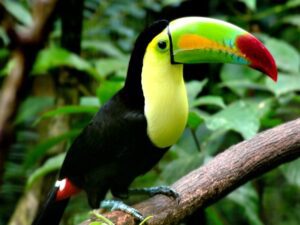 The Keel Billed Toucan is the National Bird of Belize. It is noted for its great, canoe-shaped bill which is made mostly of keratin (the same as our fingernails), and its brightly colored green, blue, red, and orange feathers. Toucans are born blind and, of note, their tongues are feathered!
The Keel Billed Toucan is the National Bird of Belize. It is noted for its great, canoe-shaped bill which is made mostly of keratin (the same as our fingernails), and its brightly colored green, blue, red, and orange feathers. Toucans are born blind and, of note, their tongues are feathered!
Toucans average about 20 inches in overall length and are found in open areas of the country with large trees. They make a loud, frog-like croak that can be heard for half a mile! Toucans are frugivores (fruit eaters) and eat by cutting with the serrated edge of their bills.
Toucans nest in holes in trees, sometimes re-engineering holes made by woodpeckers by enlarging the cavity. They lay two to four eggs which are incubated by both parents during the nesting stage which lasts from six to seven weeks. Toucans can live up to 20 years if they elude their natural predators – snakes, lizards, birds of prey, and jaguars.
Property Types in Belize
- Belize real estate
- property for sale in Belize
- land for sale in Belize
- Belize condos for sale
- Belize Business for sale
- homes for sale in Belize
Questions About Belize
- Does Belize Have a Stable Government?
Yes, it is set up as a British Commonwealth and is a democracy. We have a Prime Minister and many influences from England, the US, and Canada. - Can foreigners buy property in Belize?
YES, it is Full Title Ownership of property, just like owning in the States or Canada. If you sell property here there is NO capital gains tax!!! - When you buy property in Belize is it leased property?
No- it has full title ownership, but there are leases which is why you need to have a good real estate agent to look out for your needs. - What kind of Added cost is there when you buy property in Belize?
Once you buy a property in Belize, there is an 8% “Stamp Duty Tax” that goes to the government. The first $10,000 USD is exempt from that tax. Then there is anywhere between 1.5%-3% for closing costs. If you want Title insurance that is 1% of the sale price. If you want a more in-depth Title search you can do that for $400 USD. - How are Property Taxes in Belize?
Taxes are very reasonable. It is a land tax so even if you build a house it is the same price. Taxes in San Pedro (Ambergris Caye) are more than in the rest of Belize. For example, a beach lot in Placencia has a land tax of $38.00 BZD PER YEAR. - Can you Finance property in Belize?
Yes and No. Banks in North America will not loan money on property here in Belize. That said most local banks will loan money and the rate varies. Seller financing is sometimes an option. - Can you get Title Insurance?
Yes, you can, it runs you about 1% of the sale of the property. - Can you get homeowners insurance and car insurance?
Yes, you can get all types of insurance; Fire, theft, earthquake, flood, hurricane, etc. - What is there to do in Belize for Recreation?
Belize is home to the second-largest barrier reef in the world, so diving and snorkeling are awesome. Then we have some of the best Mayan Ruins, all types of fishing, sunbathing, cultural activities, waterfalls, and much much more. - Does Belize get a lot of Rain?
Depending on the time of year Belize can get a lot of rain. But most of the time it comes down in Buckets so to speak at night and does not affect any daily activities. The farther North you go the less rain you get. Corozal gets the least amount of rain. In the North is under 70″ per year and in the South, it can get as much as 160″ per year. - How easy is it to travel to Belize?
From the US and Canada, it is very easy. Normally a stopover is either in Houston, Dallas, Miami, or Atlanta. There is a new International Airport under construction near Placencia and it will bring in flights from Europe and make traveling to Belize easier and cheaper. It is expected to be open in 2012 - What Kinds Of Services are offered in Belize
Belize has different types of Police Officers, Fire, and EMS. There is electric, water, high-speed internet, phone, cable or satellite TV, trash pickup, hospitals, EMS, and more. Depending on where you live will depend on what type of services you will have but Belize is a developing 3rd world country. - What kind of work opportunities are there in Belize?
There are many different types of Opportunities for work in Belize, construction, resort owners, bar owners, restaurant owners, and really anything you can imagine. - Can I work in Belize?
Yes, you can work in Belize with a work permit and after you are in the country for a year then you can apply for residency. - How can I get residency?
Once you are in the country for 1 year without leaving Belize for more than 2 weeks you can apply for residency. You get residency by filling out an application, getting a physical at the doctor’s, having an HIV and TB test done; a police report, and a few other documents then you can apply. It takes about 6-8 months to get it and the whole time you cannot leave the country. - How long can I stay in Belize?
You are allowed to stay in Belize for 30 days. After 30 days, you can ask for a 30-day extension and for $100BZ you can get a 30-day extension. You may apply for a 30-day extension every month if you like and pay the $100BZ every month for 6 months. After 6 months the fee goes up to $200BZ per month. Then after you are in the country for 1 year you can apply for residency. Now if you have a work permit you do not need to go through this process. - What is the Qualified Retirement Program (QRP) and how do I apply?
The QRP is a way you can move to Belize and bring your personal belongings without duty charges. If you are 45 years old and older and if you have an income of at least $2,000 USD you can qualify. Then you can bring in your Boat, plane, car, and personal items without duty. Under the QRP you are not allowed to work. But if you are married one of you can qualify for the QRP and the other one can work if you choose. - Can I bring my animals to Belize?
Yes, you can, There is a Pet Permit form. It is pretty easy and there is no quarantine process. - What kind of money do you use in Belize?
Belize uses the Belizean Dollar (BZ) and its value for the most part is 2 BZ to 1 US dollar. - What is the cost of living in Belize?
The cost of Living in Belize is relatively cheap to live. That said some places are cheaper to live in than others. Rent is cheaper away from the beach of course. Food is cheaper the more inland you go as well. Now if you want to live like an American you will pay for it. - What is the population of Belize?
The population of Belize is around 400,000 people - Is Belize really the only English-speaking country in Central America?
Yes, it is. Although there are other languages spoken in Belize like Kekchi, Spanish, Garifuna, Creole, Chinese, and others but English is the Main language. The reason is that Belize is the melting pot of many different ethnic groups which is what makes Belize such a beautiful country. Other ethnic groups: German and Dutch Mennonites, Chinese, Arabs, and Africans account for a small percentage of the population.
More Belize Facts
Bordering Mexico and Guatemala, Belize is a small but beautiful country located in Central America but also considered as part of the Caribbean. The mixture of both of these cultures makes Belize an interesting and fascinating country. Here are some facts from the 2010 census that may be of interest to you:
Religion:
Roman Catholicism is still the largest religion in Belize, practiced by 40% of the population. Pentecostalism emerged to be the second largest practiced religion, increasing its share from 7.4% to 8.5%.
Ethnicity:
The Maya, Garifuna, Mestizo, Creole, and Mennonites are still the largest ethnic groups in the country.
Education:
- 88000 children are enrolled for formal education.
- 63,700 children are at the primary level.
- 17,200 children are at the secondary level.
- 7,400 children are at the tertiary level.
- The percentage of males outnumbered females in primary education.
- Females outnumbered males at the university level.
Information and Communication Technology:
- A quarter of those (5 years and above) interviewed, had used the internet in the previous 3 months.
- 45% of internet users were between the ages of 15 and 24, which is higher than before.
- The percentage of people using the internet between the ages of 5
- to 9, and over the age of 65, were almost equal.
- Nearly all access the internet through their computer. Very few use mobile devices for internet connection.
- There is no marked percentage difference in internet usage between males and females.
Labor Force:
- The labor force has increased by nearly 46%.
- 30,000 people are unemployed in Belize.
- 2/3 individuals of 14 years and above are either looking for a job or working.
- Twice as many women as men are unemployed. In the Corozal, Orange Walk, and Toledo districts, this number has increased too.
- The Corozal and Cayol districts have the highest rate of unemployment.
- Males in Belize earn a higher wage than females.
Fascinating Facts About Belize
Did you know that…
Belize’s Black Howler Monkeys are one of the top 10 loudest animals in the world?
Some of the exotic names for Belize’s natural wonders include the Owl-Eye Butterfly, the Blue Morpho Butterfly, the Swallow Tail Cattle Heart Butterfly, the Peanut-Head Lantern Bug, the Red-footed Booby Bird, the Lady-of-the-Night Orchid, and the False Vampire Bat?
Close to 1 million tourists visit Belize annually, 70% of whom are Americans?
Real estate agents in Belize are not licensed?
The Belizean shoreline water temperature averages between 79 to 83 degrees F?
Belize houses the only Jaguar preserve in the world (commonly known as the Jaguar Reserve or Cockscomb Basin Wildlife Sanctuary)?
Whale sharks are harmless to humans (fish eggs are not so lucky)?
Approximately 900 Mayan ruins are scattered throughout Belize?
Belize is one of the least populated countries in the world?
There are about 200 cayes (islands) in Belize, most of them located inside the Belize Barrier Reef?
Ambergris Caye, which is 25 miles long, is Belize’s largest and most developed island?
Belize’s mainland is about 180 miles long and up to 68 miles wide?
More than 400 species of fish live in the waters of Belize’s 185-mile (298-kilometre) long Barrier Reef?
There is a hyperbaric chamber for scuba divers in San Pedro, Belize?
If you select Gibnut from a menu, you’re about to chow down on a rodent which is a popular game meat in Belize?
Vanilla plants are vining orchids that grow wild in Toledo’s rainforest (and fetch a higher price than any Toledo crop including ganga!)?
Belize’s wetland habitats provide refuge for 2 of the 23 species of Crocodilians – the freshwater Morelet’s Crocodile and the saltwater American Crocodiles?
You can arrange a homestay in a Mayan village in Toledo, Belize?
Birding enthusiasts can go bananas in Belize while trying to spot over 500 species of birds that live in Belize full-time or during the winter?
About 2/3 of Belize’s forests are still intact?
Some of Belize’s most interesting place names include Laughing Bird Caye, Cattle Landing, Monkey River, Gallon Jug, Bullet Tree Falls, Rio Frio Caves, Teakettle, Coco Plum Caye, More Tomorrow, Never Delay, Mama Noots, Crooked Tree, Hummingbird Highway, Man-of-War Caye and Labouring Creek?
Belize has its own version of the Sasquatch (the legendary, North American gorilla-like creature) known as El Sisimito? El Sisimito, a creature with no knees and its feet on backwards, purportedly has a penchant for human flesh!
It is considered rude to greet people in Belize by their first names (unless you know them, of course!)?
Acceptable greetings in Belize include handshakes, pats on the back, thumbs locking….and to show great appreciation…a kiss on the cheek?
A typical Belizean breakfast consists of bread, cheese, beans, eggs or cereal with milk sipped by the kids and coffee or tea by the adults?
Many Belizeans avoid swimming in the ocean or rivers on Good Friday with the belief that it will bring good fortune?
A typical Belizean lunch might include tamales, meat pies, seafood, cassava, garnaches (fried tortillas with beans, cheese and sauce), panades (fried maize shells with beans or fish), chirmole (soup), coleslaw, escabeche (onion soup) and vegetables?
The least visited destination in Belize is the Toledo district, sometimes referred to as “the forgotten land” (1,669 square miles of rainforests, mountains, rivers and Maya Villages)?
The national motto of Belize is “Under the shade I flourish” which refers to Belize’s economy being linked, historically, to the forestry industry. However, to most Belizeans and visitors today a more appropriate motto would be “Under the hot Belizean sun we flourish”!
Belizean folklore includes a 3-foot tall, evil dwarf? The thumbless dwarf, dubbed El Duende , hangs out in the forest and punishes any kids who kill the animals. Two thumbs up for El Duende!
Belize is the only Central American country with English as its official language. However, you will hear a medley of Creole, Mestizos, and Spanish in some of the greetings you’ll hear:
Hey, how yu di do? (Translation: Hello, how are you?)
Weh di gwan? (Translation: What’s happening?) (Creole)
Buenos dias! (Translation: Good morning!) (Spanish)
Yu all rite? (Translation: How are you?)
A BRIEF HISTORY OF BELIZE
The area of Central America now called Belize was first inhabited by the Maya Indians who had an incredibly advanced civilization. They had their own writing called glyphs and their own calendar. The Maya were also skilled mathematicians and were the first culture to discover the concept of zero. They were also great architects. They built massive temples, cities, and palaces. The cities were well-planned and the temples were shaped like pyramids. Tikal, located in Guatemala, close to what is now the Belize border, is a very large Maya city and includes five pyramids. The Mayas were also skilled astronomers.
At its height, the Maya of Belize and Central America formed one of the most densely populated and culturally dynamic societies in the world. The great Mayan civilization, which had lasted 1,000 years, began to decline around the year of 900 A.D. It is unknown for sure why the Mayan civilization ended, but there are different theories. One is that the population of the Mayas grew too great. With a lack of food and possible internal fighting, the civilization fell apart, leaving behind large groups whose offspring still exist in Belize.
The first European to make Belize his home was Gonzalo Guerrero, a sailor from Palos, in Spain, who was shipwrecked along the Yucatan Peninsula in 1511 and was captured by the Maya. He later married and settled at Chactemal, now modern-day Corozal Town in northern Belize.
The first British to arrive on the coast of Belize left few records. They were pirates, buccaneers, and adventurers, who lived in rough camps which they used as bases to raid Spanish ships. Bancroft’s “History of Central America” gives buccaneer Captain Peter Wallace, with 80 men, as the first settlers at the Belize River in 1617. It is said that the word “Belize” is derived from Wallace’s name. Another theory is that the word “Belize” comes from the Maya word “balix” which means muddy waters.
Around 1650, they started to log the logwood forests of Belize. These loggers came to be known as Baymen. The British introduced slavery to Belize and imported thousands of slaves from Africa to cut the logwood which was shipped to England. Logwood is a tree from which a valuable dye used to color woolen cloth was made and was the economic basis for the British settlement in Belize for over 100 years. The intermarriage between Europeans and their African slaves led to modern-day Creoles in Belize. In 1670 the Treaty of Madrid put an end to piracy and encouraged these settlers to just cut logwood.
The population grew with the addition of disbanded British soldiers and sailors after the capture of Jamaica from Spain in 1655. The settlement had a troubled history during the next 150 years. It was subjected to numerous incursions from neighboring Spanish settlements (Spain claimed sovereignty over the entire New World except for regions in South America assigned to Portugal). No Spanish colonies were ever established in the area now called Belize but still, Spain never liked the idea of British squatters on what she claimed as her land and this led to frequent wars with the Spanish and settlers.
The Treaty of Versailles in 1783, affirmed the boundaries to cut logwood and mahogany. The boundaries were later extended by the Convention of London in 1786. But Spanish incursions to defend its rights over territory continued.
In 1798, a Spanish armada attacked the settlers at St. George’s Caye, where many of them lived. The settlers, assisted by their slaves and a British frigate, defeated the Spanish in what is known as the Battle of St. George’s Caye, which day is annually celebrated in Belize on the 10th of September.
Several more treaties with Spain gave the Baymen larger boundaries to cut logwood and mahogany. The most significant was in 1859 when the Anglo-Guatemalan Treaty gave Britain sovereignty over the territory we now know as Belize. Soon after, in 1862, the settlement became a colony and was called “British Honduras” and was recognized as part of the British Commonwealth.
From 1920-1980 independence was sought and In 1964 British Honduras gained the right to self-government. The country’s name was changed on June 1st, 1973, from “British Honduras” to “Belize” and on 21st September 1981, independence from Great Britain was finally achieved.


